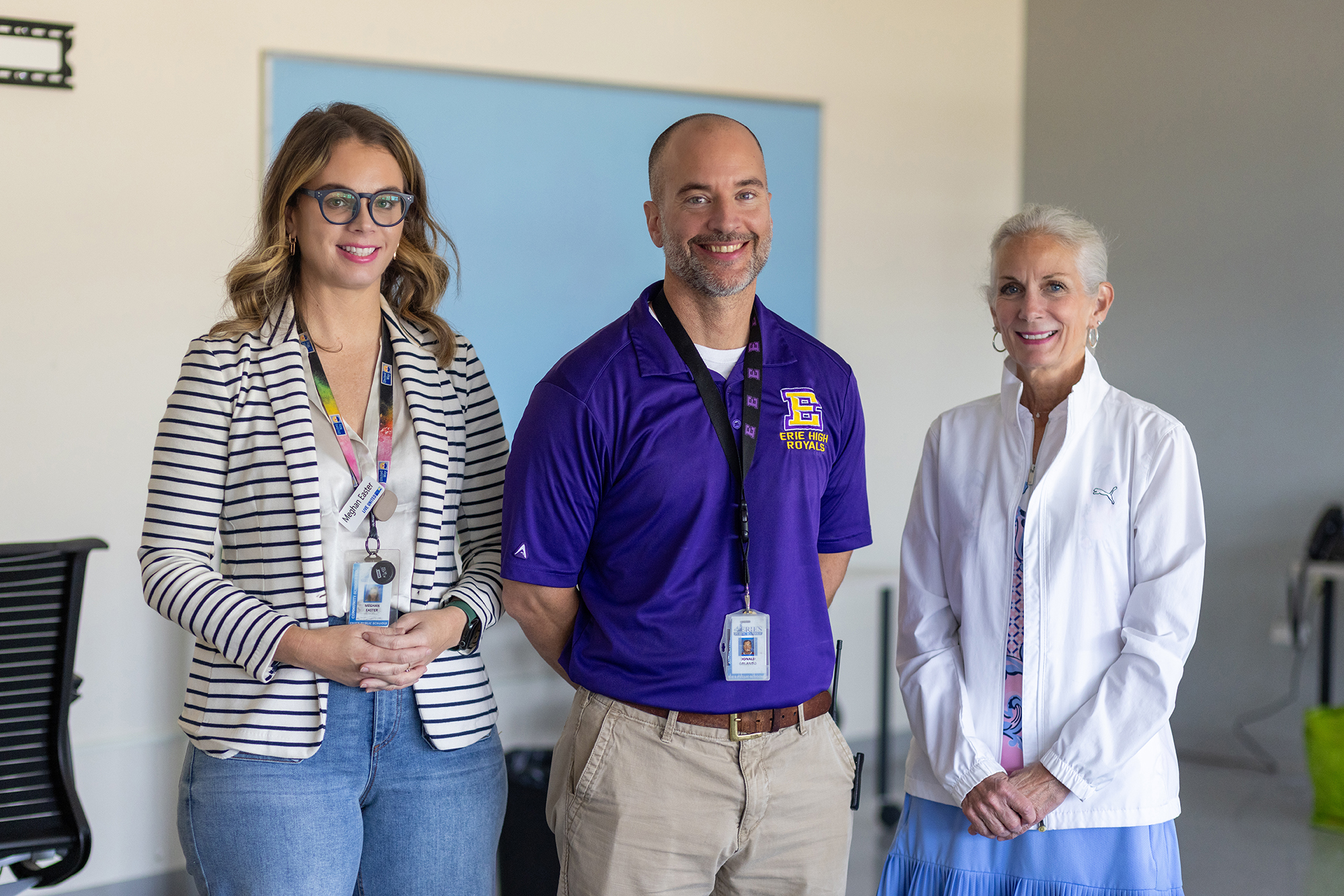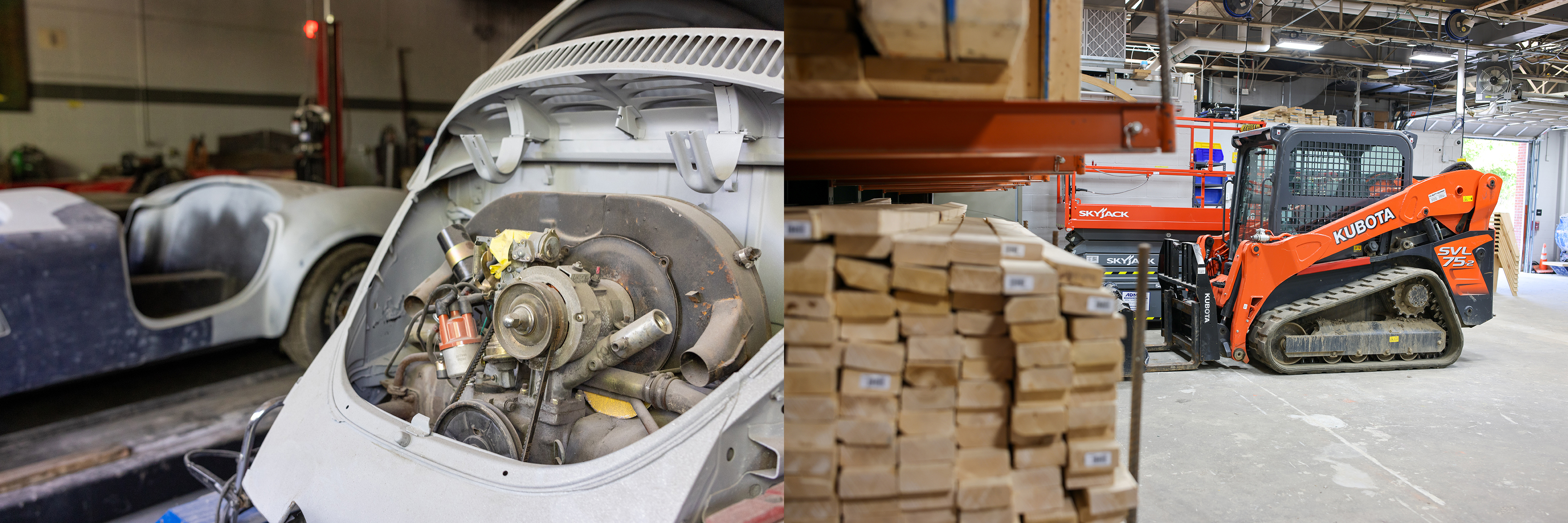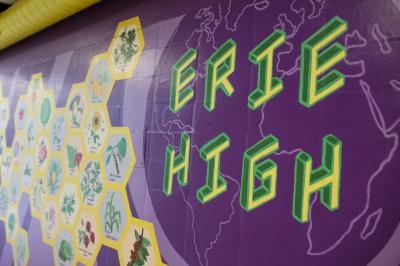Changing the Culture: Erie High Becomes a Community School
The United Way breaks unprecedented ground, points way toward brighter futures
When you tell a kid they're not good enough — through words, actions, Facebook comments — what choice do they have but to eventually believe it? When the public's words become a child's internal monologue, how does that child find the motivation to do better? Or to have pride in the choices they make and the hard work they do? What's the point of trying if all anyone is going to focus on are the negative moments, the mistakes, the poor choices of others that are completely outside of their control? Hold these thoughts in your head for a moment.
Enter Erie High School (EHS) — the City of Erie's public high school, the historic educational facility that has housed Erie's secondary students for generations, and the product of a merger in 2017 that combined Strong Vincent and East High Schools with Central High School to create a single school that allows students to choose their own "pathway to success" through either a traditional high school curriculum or one of their many career and technical education programs.
Enter also the United Way of Erie County, their Community Schools program, and their adoption of EHS as such. The United Way has created community school partnerships in all of the city's public elementary and middle schools and they are truly leading the way with their newest partnership with Erie High. According to President Laurie Root, "We are one of the few communities in the entire country to have the full continuum of community schools from grades K through 12."
What is a community school and how is that designation helping Erie High School?
A community school is a way for, well, the community to have more of an impact on outcomes of our public schools through partnerships with businesses throughout the region that supply funding, resources, as well as either a single or (in the case of EHS) a team of community school directors to help implement programs that will affect positive changes.
These changes include goals like uplifting the public's perception of the school, positively affecting the overall culture and school pride, driving up student outcomes, improving student and teacher morale and quality of life, and the overall success of the students at that community school.
These students represent the future of Erie County — our budding workforce, our decision-makers — their success is equal to the success of Erie and involving/investing the community in their outcomes is a key component.
At Erie High, the United Way has installed four community school directors — each tasked to focus on one of the four key pillars of change the organization has identified as barriers to student success. And this is all data-driven — these are not the anecdotal opinions of CEOs, executive directors, or school administrators. These needs are dictated specifically by students, faculty, staff, and neighbors through intensive polling, interaction, and communication. The four pillars are:
- To create a positive environment of wellness and learning — tackling attendance issues (for both students and teachers), providing onsite health and wellness resources, improving staff morale and school culture
- Expanded learning and extracurriculars — strengthening in-school engagement, out of school time, and opportunities for expanded learning
- School transitions and life preparedness — this pillar focuses on the needs of incoming freshmen and New American students, strengthening communication across the board
- Family and community partnerships — honing in on parent engagement, student civic engagement, and neighborhood and community outreach which will help reframe the public's perception of the school and its students
For Meghan Easter, the lead community school director at EHS and the first to start working towards the aforementioned pillars at Erie High, this is not her first rodeo. Formerly, Easter headed up the United Way Community School model at Pfeiffer-Burleigh Elementary and oversaw major changes and success through that program. She jumped at the chance to be in on the ground floor of the spearheading program at EHS.
"I'm a product of Erie's public schools. I grew up in the city. I have four children and we live in the city. I went to college for psychology and sociology and so I learned about working with people, building relationships, and how systems support or sometimes act as barriers to reaching success," Easter explains. She continues, "When this project first started, it was very interesting — because nothing like it existed in Erie and it was really about how we're supporting individual families, students, and educators to be able to do their true job. But it was also talking about systems-level change: changing processes and procedures and developing partnerships. For me, if I could have created a job based on what I wanted to do, it would be this."
 Pictured from left to right are Community School Director Meghan Easter, Erie High Principal Donald Orlando, and President of United Way Laurie Root. This team will be joined by three other Community School Directors in this office space at Erie High to begin to implement the model at the secondary education level. Photo: Jessica Hunter
Pictured from left to right are Community School Director Meghan Easter, Erie High Principal Donald Orlando, and President of United Way Laurie Root. This team will be joined by three other Community School Directors in this office space at Erie High to begin to implement the model at the secondary education level. Photo: Jessica Hunter
Changing public perception first step in changing school culture
One of Easter's first tasks (and there are many) is to work on changing the public perception of EHS — both its students and its programs. Remember my opening paragraph? The one about public opinion's effect on a child's motivation, self-esteem, and self-worth? That's exactly what Easter hopes to tackle early on — sharing out the great things about EHS, working their way out of the negative public perception that kids who end up at EHS are somehow bad. She reflects, "They (the students) recognize the negative impact and it's defeating for them. They know that good things are happening and they want to be proud of coming to school here, it's just that they want support from the people they're hearing from."
The United Way completed a year's worth of data collection at the high school before laying out a structured plan for implementing their community school model, which involved a team of employees from United Way spending a lot of time with students, surveying them, their teachers, and their parents, in order to get a greater understanding of the barriers that are keeping students from succeeding. And public perception and opinion showed up as a major barrier. One student shared with United Way staff that, "people only think that kids go to Erie High because we're not smart enough to go to Collegiate." That statement is not only heartbreaking, but motivation-killing as well. And Easter is working hard to combat that effect through social media messaging, public relations, parent communication, community and neighborhood outreach, and more.
Principal Donald Orlando reflects on this, "So many good things go on here — we have wonderful kids, wonderful staff, and we do great things. We have the Career and Technical Education (CTE) department which is strong. But when we're not putting the good news out, the only news that gets out are the unfortunate events. When people talk about Erie High, they think about all those negative things and not the good things because, well, we never put that out there." He continues, "I'm really looking forward to Meghan (Easter) helping with that — she's already sitting in on meetings saying 'well, how do people know that?' and we're making sure we're communicating. She's getting on social media to help us out. So we're definitely going to make an intentional push to get all the good news out there — what all our awesome kids and staff are doing every single day."
Easter reiterates, "This is a big goal in the first year, sharing the great things. Looking at how people are receiving information and how we tap into the pockets of the community that aren't receiving our messaging."
The United Way itself is also working on this issue. President Laurie Root relays, "We have a new event that we're doing in place of our annual meeting which will be on Oct. 16 at the Convention Center and it is to celebrate the launch of the Erie High Community School. We will be bringing in students from the CTE program and from other areas of Erie High so that our attendees can see what's going on in the school."
She continues, "This is the main high school for our city and it's really important for our teachers and students, but also for our community, to support the school because that makes a significant difference in kids showing up and how they show up. We're really hoping to, this first year, put a push on changing that public perception so we can really have a sense of support for the school and students and celebrate what's going on."
 The Career and Technical Education program at Erie High gives students another option besides a four-year college degree. There are a wealth of areas to focus on including auto mechanics and auto body (left) and construction trades (right). This program will be expanded and improved as Erie High becomes a Community School through United Way. Photos: Jessica Hunter
The Career and Technical Education program at Erie High gives students another option besides a four-year college degree. There are a wealth of areas to focus on including auto mechanics and auto body (left) and construction trades (right). This program will be expanded and improved as Erie High becomes a Community School through United Way. Photos: Jessica Hunter
Leaning in on EHS's Career and Technical Education's success
In a recent Gallup poll and follow-up story done by NPR, it was discovered that Gen Z (which includes students currently aged 12-18) is struggling to find value in school — nationally, across the board. A mere 14 percent of students polled stated that they felt that their schoolwork "challenged them in a good way." And that gap widens among students who do not want to or don't have the means to go to college. Sixty-eight percent of high schoolers say they've heard "a lot" about college while, by comparison, only 23 percent of high schoolers say they've heard a lot about "apprenticeships, certificates, and vocational programs." Meanwhile, according to employment website Indeed, those industries with the highest need for employees are health care, construction, mechanics, and tradespeople (electricians, welders, etc.).
Enter Erie High School's CTE program.
One of the most successful components of EHS is their Career and Technical Education (CTE) wing — and as I tour that area of the school with Principal Orlando, Easter, and Root, I can sense their pride growing with each area we visit. Historically, Tech Memorial/Twin Tech/Central Tech hung their hat on this program that, when the high schools merged in 2017, the public (wrongly) perceived as being eliminated. That couldn't be further from the truth, and the program is more robust now than ever.
EHS offers 18 CTE programs that prepare students for college, careers, industry certifications and state credentials, and opens a number of self-sustaining pathways for kids after graduation. These programs include: auto body technician, auto mechanics technology, childcare and support services, criminal justice, computer programming, construction trades, cosmetology, culinary arts, digital media, machine trades, medical assistant, sports medicine/rehab aide, welding, horticulture/landscaping, marketing, nursing assistant, pre-engineering, and protective services. The breadth of this program provides an unmatched opportunity for students to hone in on their interests and work toward a very real goal and having an advantage when they enter the workforce.
And, I'd wager a guess, that the kids in the CTE program at Erie High are "feeling challenged in a good way." The horticulture students maintain all of the school grounds and operate a greenhouse, learning about agriculture along with landscaping. Principal Orlando shares that if he were a student at EHS right now, that's what he'd choose to study. "You get to be outside for half of your school day!" The construction trade kids literally build a house within one of the CTE bays, complete with framing, electrical, plumbing, HVAC, etc. This is a field that challenges the kids logically and creatively, giving them skills not just for their future employment, but also for life.
Principal Orlando explains, "About half of the student population is enrolled in the CTE program. We work with the people who work in those industries and own the businesses — they help us design the curricula, direct us on what pieces of machinery to buy, what certifications students need, etc. So when a student graduates from the program, they're immediately employable. They can go right into the workforce and make a livable wage, or they can go to a two or four-year school."
Root expands, "Many of the certifications that the student needs are paid for by the school, so they don't have to be paid out of pocket by the student. So, when they graduate, they [can] go right into the workforce."
She goes on to explain how the United Way Community School model can help expand and improve this program, "Being a Community School will help with making that connection to a broader number of businesses in this community. We've had probably about 100 business leaders that we've brought through the school in the last school year and there were a lot who did not know what was going on here. Many were very interested in making that connection because this is their future workforce. It's a really tight employee market right now, so hopefully over the next couple years we'll be able to hone a better connection with the business community and the students here."
Photo: Jessica Hunter
The future's so bright
Easter and the other three community school directors — recently announced by the United Way as Bryan Barton, Shateria Franklin (40 Under 40 Class of 2023), and Kane Patron — have a dedicated space within the ample 550,000-square-foot, newly renovated school which spans four city blocks (putting to rest that negative public perception that the school is not big enough to accommodate the student body — it is, most assuredly, big enough). They will each have an office/coworking area alongside a community closet, which is an area of the school where students can access food, hygiene products, clothing, etc. to help fill some basic needs that, if not met, inhibit a student's ability to focus and learn.
Root explains, "This will be the first out of the local community schools that will actually have a team of community school directors and so the collaboration will be huge amongst the team. They all have different pillars, so all the components interconnect."
The United Way, the Community School directors, and the administration and staff at Erie High are all poised to embark on a massive journey, beginning this year — one that leads away from the negative perceptions of the past and towards a brighter future for the students, the school, and the community. We are all in the same boat, here in Erie, and what benefits each and every child is a benefit to us all. The United Way is shining a light on that connection and acting as a beacon for Erie's future success. Let's all right our ships to follow that light.
For more information on the United Way's Community School program visit unitedwayerie.org
To learn more about Erie High School, their CTE Program, or for enrollment information visit eriesd.org/eriehigh
Erin Phillips can be reached at erin@eriereader.com




